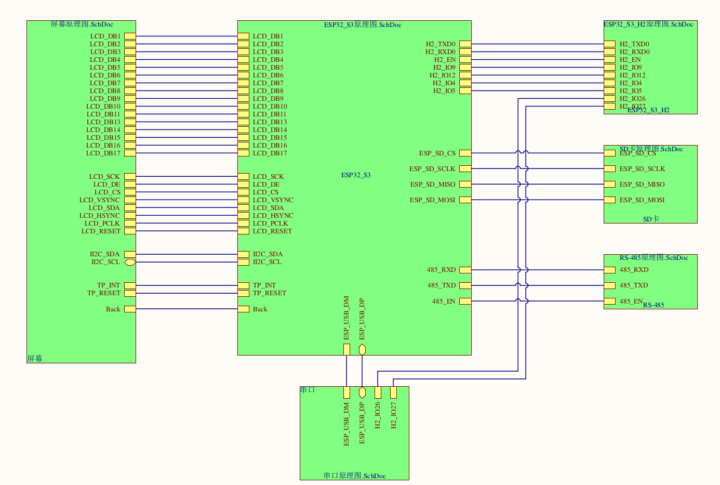LILYGO T-Panel is both a 4-inch HMI display and IoT gateway based on ESP32-S3 WiFi 4 and Bluetooth LE 5 microcontroller and an ESP32-H2 module with Bluetooth LE 5 and an 802.15.4 radio for Zigbee, Thread, and Matter connectivity.
Last year, Espressif introduced the ESP-Thread Board Router/Zigbee gateway board with ESP32-S3 and ESP32-H2 to show how both chips could be combined to create IoT gateways. But I don’t think I had seen a company design a product based on both ESP32-S3 and ESP32-H2 until I saw the T-Panel which also includes an RS485 interface and Qwiic expansion connectors for good measure.
T-Panel specifications:
- Wireless chips/modules
- Wireless SoC – ESP32-S3R8 dual-core Tensilica LX7 microcontroller @ 240 MHz
- 2.4 GHz 802.11n WiFi 4 and Bluetooth 5.0 LE connectivity
- Memory – 8MB PSRAM
- Wireless module – ESP32-H2-MINI-1 module
- MCU – Espressif Systems ESP32-H2 32-bit RISC-V microcontroller at up to 96 MHz with 320 KB SRAM, 128 KB ROM, 4 KB LP memory, Bluetooth 5.2 LE/Mesh and 802.15.4 (Zigbee/Thread/Matter) radios.
- Storage – 4MB flash storage
- PCB antenna
- Dimensions – 13.2 x 16.6 x 2.4 mm
- Wireless SoC – ESP32-S3R8 dual-core Tensilica LX7 microcontroller @ 240 MHz
- Storage
- Storage – 16MB SPI flash (W25Q128) attached to ESP32-S3 MCU
- MicroSD card slot
- Display – 4-inch IPS LCD with 480×480 resolution using ST7701S SPI+RGB controller; The display also seems to support touch through I2C when we look at the T-Panel schematics (and silkscreen on the PCB), but it’s not a feature highlighted by the company…
- USB – 2x USB Type-C ports (one for ESP32-S3, the other for ESP32-H2) for programming
- Serial – 4-pin terminal block connected to RS485 / CAN Bus transceiver module (optional)
- Expansion
- 2x Qwiic connectors (I2C and UART)
- 16-pin GPIO header for ESP32-H2
- XL9535 GPIO expansion chip for extra IO on ESP32-S3 and ESP32-H2
- Misc
- 3D antenna for ESP32-S3 WiSoC
- 4x buttons: Boot and Reset connected to ESP32-S3; Boot and Reset connected to ESP32-H2
- Power Supply – 7V to 24V via 2-pin terminal block
- Dimensions – 89 x 89 x 28.5mm

The specifications mention “Arduino, PlatformIO-IDE, and Micropython” are supported, but that’s just a copy/paste, the actual GitHub repository only provides basic instructions for PlatformIO and the Arduino IDE and further explains that the “ESP32-H2 can only be programmed using the Arduino IDE”.
Available resources include firmware files for ESP32-S3 and ESP32-H2, sample code for the key hardware features (display with Arduino_GFX and LVGL, RS485, SD card, WiFi, etc…), and the PDF schematics. Like other LILYGO hardware, the T-Panel is absolutely not a plug-and-play solution and should be viewed as a “bring-your-own firmware solution” either some Arduino code or a firmware based on Espressif’s ESP Thread Border Router SDK for instance.
LILIGO’s T-Panel can be purchased fitted with an RS485 transceiver on Aliexpress for $58.98 including shipping.

Jean-Luc started CNX Software in 2010 as a part-time endeavor, before quitting his job as a software engineering manager, and starting to write daily news, and reviews full time later in 2011.
Support CNX Software! Donate via cryptocurrencies, become a Patron on Patreon, or purchase goods on Amazon or Aliexpress






